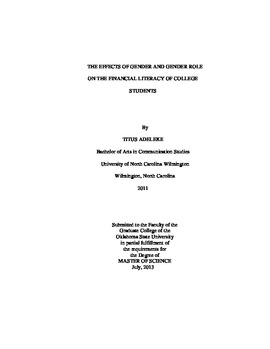| dc.contributor.advisor | Foubert, John | |
| dc.contributor.author | Adeleke, Titus | |
| dc.date.accessioned | 2014-09-24T14:18:24Z | |
| dc.date.available | 2014-09-24T14:18:24Z | |
| dc.date.issued | 2013-07-01 | |
| dc.identifier.uri | https://hdl.handle.net/11244/11141 | |
| dc.description.abstract | The financial literacy of young adults has been studied extensively. Specifically, the focus of much of the literature has been on college students and their overall financial decision making ability. A concern has arisen that many college students are going through college and then graduating without a sound base of personal financial knowledge to make responsible decisions. Additionally, research has shown through various financial literacy surveys that there is a discrepancy between the financial literacy knowledge that men possess versus women. This difference, while not substantial, is a common theme throughout the majority of the research. The present study used Bem's Gender Schema Theory (1973) as a framework to examine whether and if so how the gender roles of college students affects their financial literacy. A financial knowledge survey was used to measure the personal financial literacy levels (knowledge) of a sample of undergraduate college students. These variables, combined with self-reported gender, were all part of a two by four analysis of variance with gender and gender role as independent variables and financial literacy as the dependent variable.The analysis of variance yielded no relationship between gender or gender role and the financial literacy of college students. Correlation analysis yielded significant relationships between the year in school of a college student and their financial literacy level. Additionally, a significant relationship existed between the age of the participants and their financial literacy levels. The two by four ANOVA analyses found no relationships between the categories of the BSRI in masculine, feminine, androgynous, and undifferentiated in the financial literacy levels of students. Analysis of the data did reveal a low financial literacy level of the convenience sample chosen for the study. Conclusions drawn from these results suggest that the sample chosen may have limited the final results of the study and a different sample, such as a random sample, may have yielded more varied results. The significance found between the correlations of financial literacy levels and the year in school of the students as well as their age suggests that students may be experiencing personal financial management at different times in their lives. Future research should focus on high school students before they attend college to assess their exposure and experiences when they deal with personal finance as well as improving the financial literacy levels of all college students at various ages. Additionally, future research should seek to find a new sex role orientation scale or create one's own to stay up to date with societal changes concerning gender role. | |
| dc.format | application/pdf | |
| dc.language | en_US | |
| dc.publisher | Oklahoma State University | |
| dc.rights | Copyright is held by the author who has granted the Oklahoma State University Library the non-exclusive right to share this material in its institutional repository. Contact Digital Library Services at lib-dls@okstate.edu or 405-744-9161 for the permission policy on the use, reproduction or distribution of this material. | |
| dc.title | Effects of Gender and Gender Role on the Financial Literacy of College Students | |
| dc.type | text | |
| dc.contributor.committeeMember | Moore, Tami | |
| dc.contributor.committeeMember | Bird, Lee | |
| osu.filename | Adeleke_okstate_0664M_12828.pdf | |
| osu.accesstype | Open Access | |
| dc.description.department | Education | |
| dc.type.genre | Thesis | |
| dc.subject.keywords | education | |
| dc.subject.keywords | financial | |
| dc.subject.keywords | gender | |
| dc.subject.keywords | literacy | |
